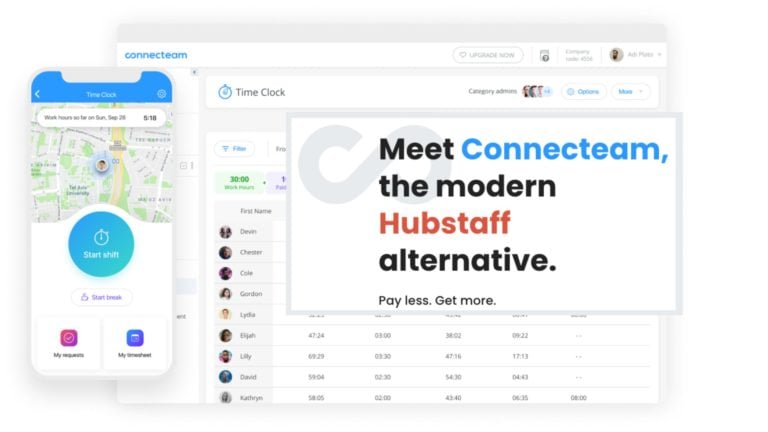Effective time tracking and productivity monitoring are crucial for modern businesses. But with numerous options available, choosing the right tool can be challenging.
That’s why I’ve done the legwork for you. Here’s my honest comparison of Hubstaff vs. Time Doctor—2 leading solutions—to help you make an informed decision for your team.
What Is Hubstaff?

Hubstaff is a comprehensive time tracking and productivity monitoring for office-based, remote, and hybrid teams. It features rich capabilities for detailed time tracking, activity monitoring, project management, scheduling, and reporting.
It’s most ideal for office settings, and it’s highly suitable for businesses in the healthcare sector due to its HIPAA compliance. This focus on data security and privacy could make it a valuable tool across various industries.
Key features of Hubstaff
Time tracking
Hubstaff provides different options for logging work hours. For instance, employees can clock in and out using a mobile or desktop app, or they can download a Chrome extension, which integrates seamlessly with their browser for easy access. Hubstaff tracks total hours, work breaks, and overtime.
Activity monitoring
Activity monitoring works on desktop devices, capturing screenshots, apps, keystrokes, and URLs when a worker is clocked in so you can ensure they’re staying on task. I appreciate that it’s designed to balance productivity monitoring with employee privacy, as it records activity only during work hours and offers options for blurred screenshots.
GPS tracking
The GPS tracking feature is designed for teams that require location monitoring, such as those in construction or field services. It allows for real-time location tracking of employees.
Scheduling
Hubstaff’s scheduling tool simplifies shift creation and assignment. You can set up schedules by selecting the create option, specifying times, assigning employees, and setting durations.
Although it’s straightforward, this tool doesn’t let you add project or location details to shifts or warn you about overlapping schedules.
Project management
Hubstaff’s visual project management tool offers different views—List, Timeline, and Kanban—that help you organize and track your projects efficiently. You can create tasks within project cards, set up dependencies that link tasks based on their sequence, and add checklists to ensure all subtasks are completed. This setup helps you visualize project flow and manage tasks.
Hubstaff pricing

Hubstaff offers 4 tiered pricing plans designed to accommodate the needs of different sizes and types of teams:
- Starter: $7/seat/month ($4.99/seat/month when billed annually). Includes basic time tracking and limited reporting features.
- Grow: $9/seat/month ($7.5/seat/month when billed annually). Adds tasks, and project budgeting.
- Team: $12/seat/month ($10/seat/month when billed annually). Adds extensive monitoring with unlimited screenshots and timesheet approvals.
- Enterprise: $25/seat/month (subject to change after 12 months based on custom requirements). Adds advanced security features and full customization.
What Is Time Doctor?

Time Doctor is a time-tracking and employee monitoring tool tailored for freelancers and businesses with hybrid or remote work models. It includes comprehensive features like detailed time tracking, employee monitoring, project management, and thorough reporting.
Time Doctor is particularly advantageous for businesses that operate on an hourly billing model, need to enhance productivity, or manage dispersed teams. It excels in providing granular insights into employees’ work patterns and project progress.
Key features of Time Doctor
Time tracking
Time Doctor offers various options for tracking hours worked, including desktop and mobile apps and a Chrome extension. I appreciate the offline tracking capability, which records time even when users are disconnected from the internet.
However, I noticed that synchronization between mobile and desktop versions isn’t always seamless, which can lead to discrepancies in time reporting. Plus, the platform lacks GPS tracking.
Employee productivity monitoring
This feature uses screenshots, keyboard/mouse activity tracking, and web/app usage monitoring to provide insights into employee productivity. I found the ability to set custom productivity ratings for specific websites and apps particularly useful. You can categorize each website or application as “productive,” “unproductive,” or “neutral” based on the work’s nature and your team’s specific needs. For instance, a social media site could be “productive” for a social media manager but “unproductive” for other roles.
However, the data usage from frequent screenshot uploads can be a concern for teams with limited internet bandwidth.
Project management
While not a full-fledged project management solution, Time Doctor offers basic project tracking features. I found the ability to set hourly budgets and cost estimates for projects helpful for monitoring project progress and costs.
However, more advanced project management functionality requires integration with third-party tools.
Scheduling
Time Doctor’s scheduling feature, while basic, effectively allows you to set up work schedules, manage leave, and monitor attendance.
Time Doctor pricing

Time Doctor also uses a tiered pricing structure but starts with a more feature-rich base plan:
- Basic Plan: $7/user/month ($5.90/user/month when billed annually). Includes time tracking, task management, and unlimited screenshots.
- Standard Plan: $14/user/month ($11.70/user/month when billed annually). Adds integrations, more detailed reporting, and client login access.
- Premium Plan: $20/user/month ($16.70/user/month when billed annually). Offers VIP support, concierge account setup, and additional security features like video screen captures.
- Enterprise Plan: Pricing by quote. Comes with VIP support, enterprise-grade security, customizability, and dedicated customer success manager.
Hubstaff vs. Time Doctor: Which Is better?
Here’s a head-to-head comparison of Time Doctor’s and Hubstaff’s features.
💻 Usability and interface
Hubstaff ✅
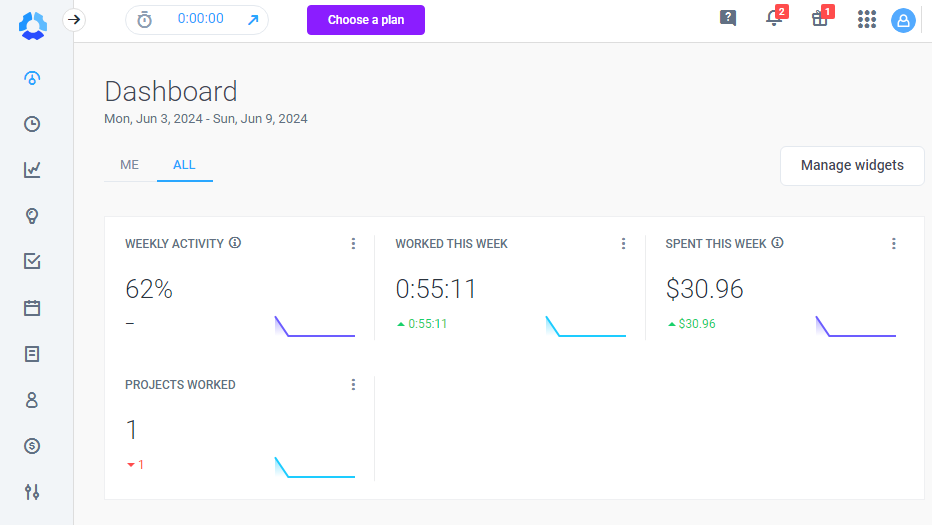
Hubstaff’s web app interface is well-organized, with a clear panel on the left side that lists key features for easy navigation. The inclusion of short walkthrough videos is beneficial for first-time users, helping ease the learning curve.
However, its mobile app offers only basic functionalities, such as time tracking and viewing reports, which might be insufficient for those needing remote access to other features.
Time Doctor
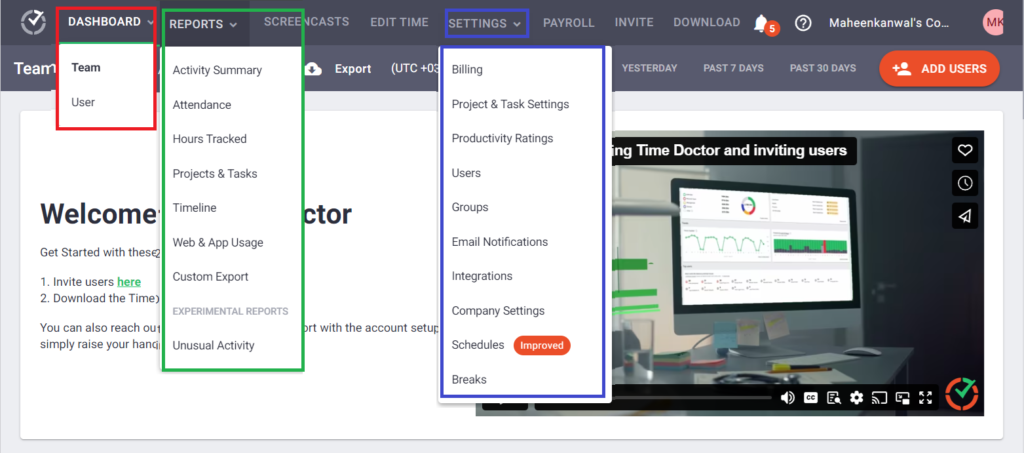
Time Doctor’s interface is functional and straightforward, although the design isn’t very modern.
The dashboard presents various productivity metrics, and I liked the ability to switch between data for different users, groups, or the entire team. The color scheme is easy on the eyes and helps important elements stand out.
The desktop version offers many features, but unfortunately, it significantly slowed down my computer, affecting its usability. And similar to Hubstaff, the mobile app is quite basic and focused primarily on time tracking, which might not suffice for field workers.
🕒Time tracking
Hubstaff ✅
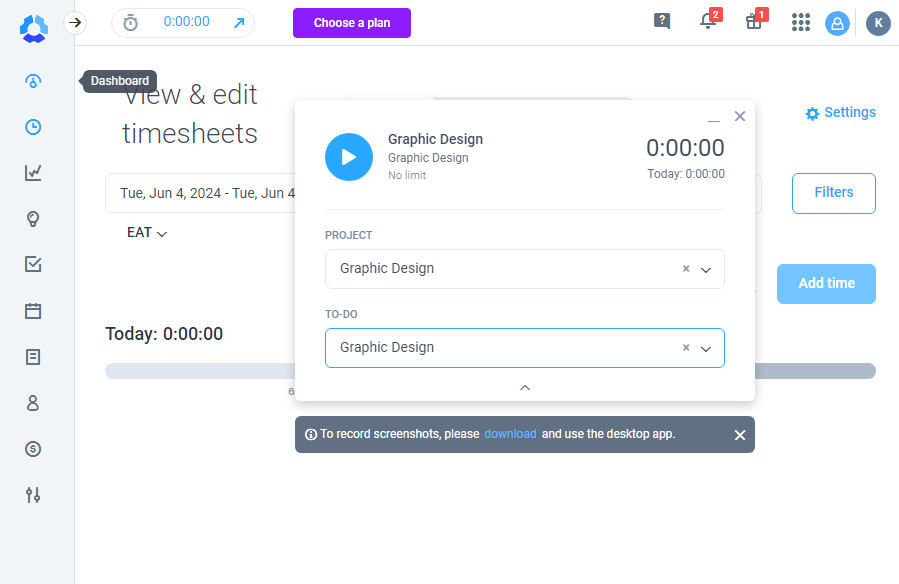
In addition to its various time tracking methods, Hubstaff offers tools to improve timesheet accuracy and prevent time fraud, such as preventing timesheet edits and creating automatic timer policies.
For instance, I appreciate the geofencing feature that uses GPS to automatically start and stop the timer when employees enter or leave designated work areas. I wish the platform included facial verification, which I find useful for preventing buddy punching.
Further, the break tracking feature helps businesses comply with labor laws—for example, by notifying employees when it’s time to take breaks and tracking both paid and unpaid breaks.
Overall, Hubstaff seems to excel in accurate time tracking, geofencing, and break tracking.
Time Doctor
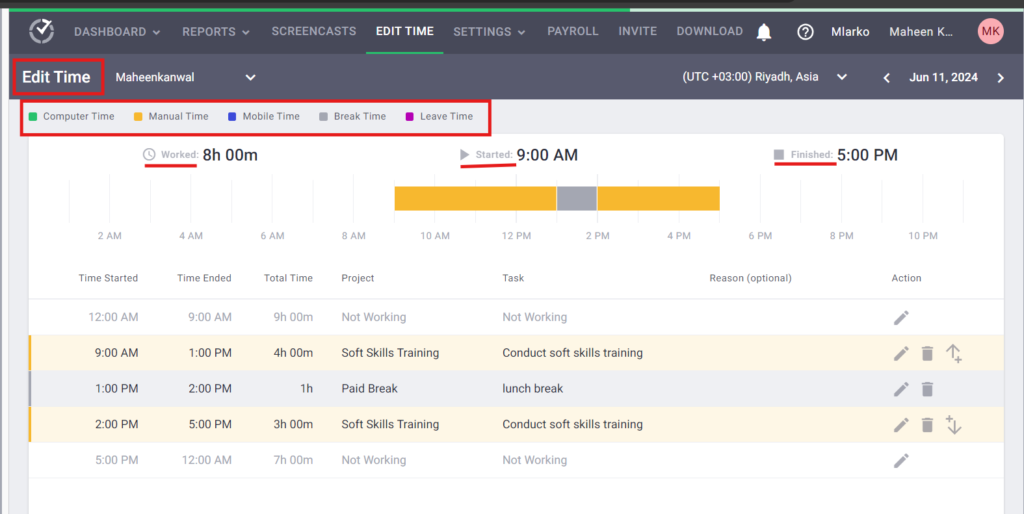
Time Doctor’s time tracking is straightforward on both desktop and mobile, with intuitive options for starting, pausing, and stopping the timer. The offline tracking capability records time without an internet connection and syncs later. The system automatically detects idle time and breaks, differentiating between active work and downtime and stopping the timer during downtime to ensure accurate tracking.
While the idle detection feature is cool, I encountered some issues during testing. The Chrome extension timer’s idle detection wasn’t always accurate, leading to inaccurate time tracking. Also, the synchronization between mobile and desktop apps had some flaws. Time Doctor recommends using 1 device at a time to avoid these potential inaccuracies.
👀Employee productivity monitoring
Hubstaff

Hubstaff’s activity monitoring really caught my attention with its desktop-centric approach. I found its key features quite effective, including screenshot recording at preset intervals and tracking of apps and URLs to monitor time spent on work-related activities.
The platform also offers smart notifications that give weekly updates on employee productivity and alert you to any unusually high or low activity levels.
Time Doctor ✅

Time Doctor offers advanced productivity monitoring tools that go beyond simple time tracking. I found that it effectively monitors employees’ keyboard and mouse activity to identify when users are inactive or “idle.” In addition, its screenshot capture uses machine learning to categorize activities on the screen into productive or unproductive. The Premium plan even offers video recording of screen activity.
I appreciate that Time Doctor enables you to blur or disable screenshots—a feature I found crucial for addressing team members’ concerns about their privacy.
While both tools offer powerful productivity monitoring features, Time Doctor provides more detailed insights and customization options.
🗂️Project management
Hubstaff ✅
Hubstaff’s project management features—like the List, Kanban, and Timeline views—help you visualize project progress and ensure tasks flow smoothly from start to finish. I particularly value the Kanban view for its ability to help you visually track task progress.
While Hubstaff excels at organizing tasks and mapping out dependencies, it lacks built-in reminders and priority settings. This means you might need additional tools for managing deadlines and prioritizing tasks. But for general project tracking and coordination, Hubstaff does well, making it ideal for teams looking for straightforward project oversight.
Time Doctor ✅
I find that Time Doctor serves well for basic project tracking. I particularly appreciated how straightforward it was to establish hourly budgets and calculate costs for projects, which helps you keep a close eye on financials and project milestones.
However, for more complex project management needs (like prioritizing tasks), Time Doctor requires integration with external platforms like Trello and Asana. Still, these integrations are seamless, and this setup enhances Time Doctor’s functionality by connecting it with tools that might already be integral to your project workflows.
While each platform brings distinct strengths to the table, both have room for improvement.
📅Scheduling
Hubstaff ✅
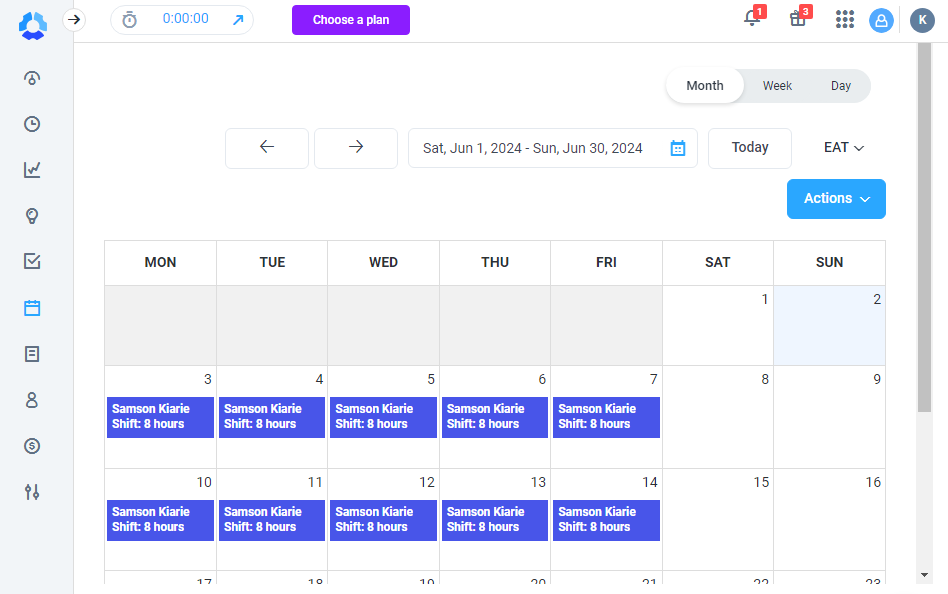
I found Hubstaff’s scheduling capabilities to be effective for straightforward shift management. The tool’s integration with calendars helps keep everyone on the same page.
However, the absence of features to alert you when there are schedule overlaps means you must frequently check the schedules when creating shifts to avoid scheduling conflicts, which can be cumbersome.
Time Doctor

Time Doctor’s scheduling feature is quite basic. You can define the start and end times when creating work schedules and handling leave—and that’s it. You must specify when leave lasts a whole day, and the scheduling tool lacks advanced capabilities like duplicating shifts, shift swapping, or color-coding.
Overall, I don’t think Time Doctor’s scheduling is up to par with Hubstaff’s, though both tools have room for improvement.
📊Reporting and analytics
Hubstaff
Hubstaff’s reporting capabilities felt comprehensive, with various report categories including general, payments, project budgets, time-off, schedule, and invoices. I found generating and exporting reports easy, and the option to schedule recurring reports was convenient. However, the reports mainly compile raw data without providing AI-driven insights or predictions.
Time Doctor ✅
Time Doctor offers a wide range of reports, from activity summaries to web and app usage reports, as well as tracking time off balances and accruals reports. I particularly liked the timeline report that visualizes an employee’s daily activities. The custom export feature allowed me to tailor reports to specific needs.
While the platform uses some algorithms to highlight trends, it doesn’t claim to use advanced AI functionalities for providing insights or predictions.
Still, Time Doctor offers a more dynamic look at employee activities compared with Hubstaff.
🛡️Security and compliance
Hubstaff ✅
I was impressed by Hubstaff’s commitment to data privacy and security. It encrypts data in transit and at rest and adheres to GDPR when processing and deleting data. The HIPAA compliance and SOC 2 Type II certification make it suitable for healthcare businesses and those requiring stringent data protection measures.
Time Doctor ✅
Time Doctor also emphasizes security, with features like data encryption and 2-factor authentication. I appreciated the granular access controls and user permissions. The compliance with HIPAA and GDPR regulations was also reassuring.
⚙️Integrations
Hubstaff
Hubstaff integrates with over 30 tools across project management, communication, and payroll areas. Notable integrations include Asana, Trello, Jira, and Slack, allowing seamless time tracking within these platforms. Payroll integrations with QuickBooks and Wise automate payment processes effectively.
Time Doctor ✅
Time Doctor offers a more extensive range of integrations, covering over 60 tools. These include various project management software, communication platforms, and helpdesk solutions. The integration with helpdesk solutions like Zendesk is particularly useful for managing support tasks and billing.
Despite its broad integration scope, Time Doctor’s lack of compatibility with Microsoft Teams might be a limitation for some organizations.
⭐ Hubstaff vs. Time Doctor: What Are People Saying About Them?
Hubstaff and Time Doctor have ratings of 4.6 and 4.5 on Capterra, respectively. Here’s what users are saying about each.
Hubstaff reviews ⭐⭐⭐⭐
It tracks time so well and smooth… it also looks great, nice friendly layout.
It is complicated and difficult to use to track time by project. Project time totals should display in real time in the app for each project. Also, there should be no delay in these totals appearing and updating on the web project tracking page.
Time Doctor reviews ⭐⭐⭐⭐
The best assistance, not solely in monitoring your team but making sure you have figured out important aspects in efficient management of your team and the responsibilities which need to be taken care of.
Well, sometimes it doesn’t synchronize well and I have to remember exactly what I was working those times and finally manually set on TD’s dashboard.
Connecteam vs. Hubstaff and Time Doctor
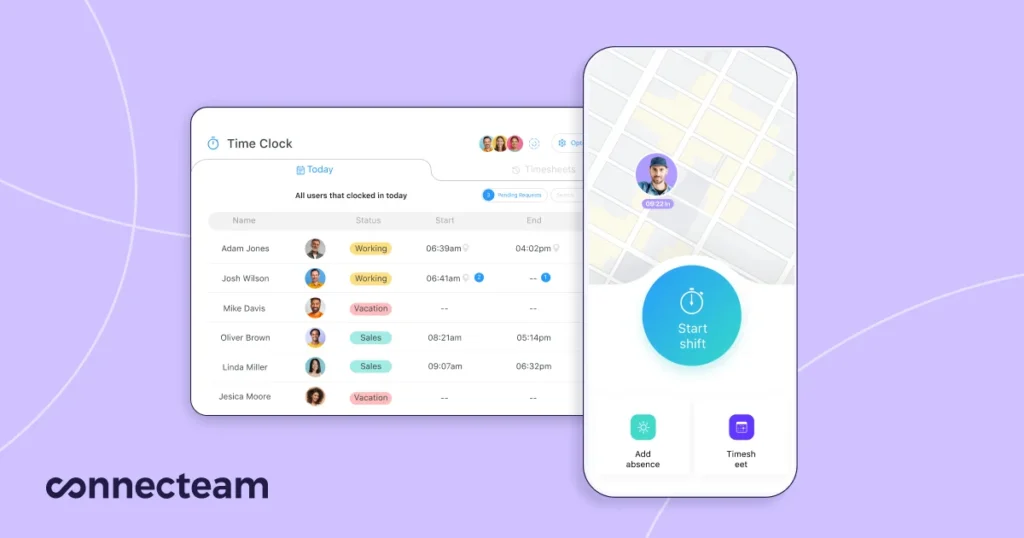
While Hubstaff and Time Doctor offer several time tracking and productivity monitoring features, I find that Connecteam provides a more comprehensive workforce management solution.
Its mobile functionality and less invasive monitoring suit businesses with field workers or those prioritizing employee trust and autonomy. Here’s why Connecteam is a perfect Hubstaff substitute and Time Doctor alternative.
Accurate time and GPS tracking
Connecteam offers a precise employee time clock with a real-time GPS tracker and geofencing—plus various methods of clocking in and out, including a mobile app and central kiosk. I found the system particularly useful for allowing employees to clock in and out with a single tap.
I appreciated how it supports job-specific time tracking and generates automated timesheets, which significantly streamlines payroll processes.
Balanced approach to employee monitoring
Connecteam’s monitoring focuses on task and location tracking rather than invasive screenshots. I was impressed by how you can track project and task progress, view completed tasks, and monitor overall productivity without compromising employee privacy. You can also use location tracking responsibly alongside time tracking to verify time entries.
Intuitive drag-and-drop scheduling
The employee scheduling feature in Connecteam allows for easy shift creation and adjustment. I appreciated the drag-and-drop scheduler and the support for recurring shifts, open shift assignments, and shift swapping between employees.
Comprehensive project management
Connecteam’s project management functionality includes a rich task management app. You can easily create, assign, and track tasks. Plus, you can set deadlines, add task details and attachments, and more in real time.
And much more…
Connecteam offers a wealth of additional tools for daily operations—plus tons of tools for HR and communications. From training new hires to using the online team chat to creating and storing digital forms, you can use Connecteam for so many aspects of your business.
What’s more? Connecteam stands out with its pricing options. It offers a free forever plan that’s ideal for small businesses. For larger teams, paid plans start at just $29/month for up to 30 users (less than a dollar per person), with each additional user costing only $0.5. This makes it accessible compared with Hubstaff and Time Doctor, which both offer tiered plans starting from $7/user/month but lack free plans.
Summary
Hubstaff and Time Doctor are efficient time tracking and productivity monitoring tools for hybrid workforces. While Hubstaff is ideal for teams that need time tracking software with GPS capabilities and project management integration, Time Doctor is great for businesses that require extensive integrations and detailed productivity insights.
In contrast, Connecteam offers a unique advantage with its all-in-one platform that combines communication, scheduling, and HR management—making it a standout choice for businesses seeking a comprehensive workforce solution.


